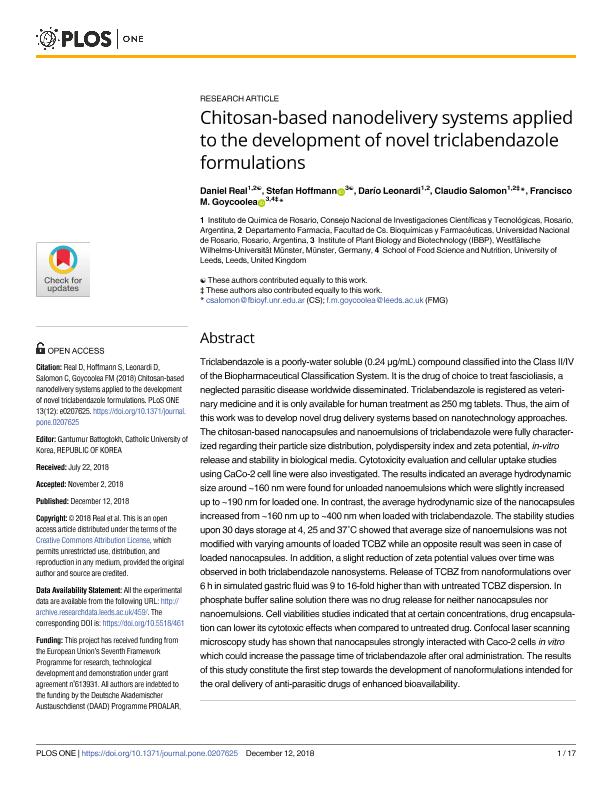Mostrar el registro sencillo del ítem
dc.contributor.author
Real, Daniel Andres

dc.contributor.author
Hoffmann, Stefan
dc.contributor.author
Leonardi, Darío

dc.contributor.author
Salomon, Claudio Javier

dc.contributor.author
Goycoolea, Francisco M.
dc.date.available
2019-10-23T21:00:26Z
dc.date.issued
2018-12
dc.identifier.citation
Real, Daniel Andres; Hoffmann, Stefan; Leonardi, Darío; Salomon, Claudio Javier; Goycoolea, Francisco M.; Chitosan-based nanodelivery systems applied to the development of novel triclabendazole formulations; Public Library of Science; Plos One; 13; 12; 12-2018; 1-17
dc.identifier.issn
1932-6203
dc.identifier.uri
http://hdl.handle.net/11336/87178
dc.description.abstract
Triclabendazole is a poorly-water soluble (0.24 μg/mL) compound classified into the Class II/IV of the Biopharmaceutical Classification System. It is the drug of choice to treat fascioliasis, a neglected parasitic disease worldwide disseminated. Triclabendazole is registered as veterinary medicine and it is only available for human treatment as 250 mg tablets. Thus, the aim of this work was to develop novel drug delivery systems based on nanotechnology approaches. The chitosan-based nanocapsules and nanoemulsions of triclabendazole were fully characterized regarding their particle size distribution, polydispersity index and zeta potential, in-vitro release and stability in biological media. Cytotoxicity evaluation and cellular uptake studies using CaCo-2 cell line were also investigated. The results indicated an average hydrodynamic size around ∼160 nm were found for unloaded nanoemulsions which were slightly increased up to ∼190 nm for loaded one. In contrast, the average hydrodynamic size of the nanocapsules increased from ∼160 nm up to ∼400 nm when loaded with triclabendazole. The stability studies upon 30 days storage at 4, 25 and 37°C showed that average size of nanoemulsions was not modified with varying amounts of loaded TCBZ while an opposite result was seen in case of loaded nanocapsules. In addition, a slight reduction of zeta potential values over time was observed in both triclabendazole nanosystems. Release of TCBZ from nanoformulations over 6 h in simulated gastric fluid was 9 to 16-fold higher than with untreated TCBZ dispersion. In phosphate buffer saline solution there was no drug release for neither nanocapsules nor nanoemulsions. Cell viabilities studies indicated that at certain concentrations, drug encapsulation can lower its cytotoxic effects when compared to untreated drug. Confocal laser scanning microscopy study has shown that nanocapsules strongly interacted with Caco-2 cells in vitro which could increase the passage time of triclabendazole after oral administration. The results of this study constitute the first step towards the development of nanoformulations intended for the oral delivery of anti-parasitic drugs of enhanced bioavailability.
dc.format
application/pdf
dc.language.iso
eng
dc.publisher
Public Library of Science

dc.rights
info:eu-repo/semantics/openAccess
dc.rights.uri
https://creativecommons.org/licenses/by-nc-sa/2.5/ar/
dc.subject
CHITOSAN
dc.subject
NANODELIVERY
dc.subject
TRICLABENDAZOLE
dc.subject.classification
Otras Ciencias Químicas

dc.subject.classification
Ciencias Químicas

dc.subject.classification
CIENCIAS NATURALES Y EXACTAS

dc.title
Chitosan-based nanodelivery systems applied to the development of novel triclabendazole formulations
dc.type
info:eu-repo/semantics/article
dc.type
info:ar-repo/semantics/artículo
dc.type
info:eu-repo/semantics/publishedVersion
dc.date.updated
2019-10-16T19:16:00Z
dc.journal.volume
13
dc.journal.number
12
dc.journal.pagination
1-17
dc.journal.pais
Estados Unidos

dc.journal.ciudad
San Francisco
dc.description.fil
Fil: Real, Daniel Andres. Consejo Nacional de Investigaciones Científicas y Técnicas. Centro Científico Tecnológico Conicet - Rosario. Instituto de Química Rosario. Universidad Nacional de Rosario. Facultad de Ciencias Bioquímicas y Farmacéuticas. Instituto de Química Rosario; Argentina
dc.description.fil
Fil: Hoffmann, Stefan. Westfalische Wilhelms Universitat; Alemania
dc.description.fil
Fil: Leonardi, Darío. Consejo Nacional de Investigaciones Científicas y Técnicas. Centro Científico Tecnológico Conicet - Rosario. Instituto de Química Rosario. Universidad Nacional de Rosario. Facultad de Ciencias Bioquímicas y Farmacéuticas. Instituto de Química Rosario; Argentina
dc.description.fil
Fil: Salomon, Claudio Javier. Consejo Nacional de Investigaciones Científicas y Técnicas. Centro Científico Tecnológico Conicet - Rosario. Instituto de Química Rosario. Universidad Nacional de Rosario. Facultad de Ciencias Bioquímicas y Farmacéuticas. Instituto de Química Rosario; Argentina
dc.description.fil
Fil: Goycoolea, Francisco M.. University of Leeds; Reino Unido
dc.journal.title
Plos One

dc.relation.alternativeid
info:eu-repo/semantics/altIdentifier/doi/http://dx.doi.org/10.1371/journal.pone.0207625
dc.relation.alternativeid
info:eu-repo/semantics/altIdentifier/url/https://journals.plos.org/plosone/article?id=10.1371/journal.pone.0207625
Archivos asociados
